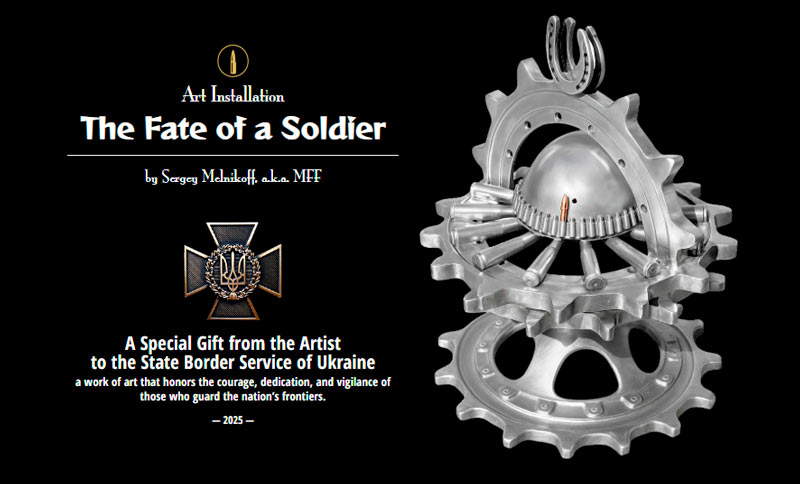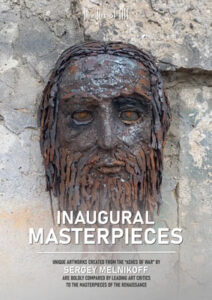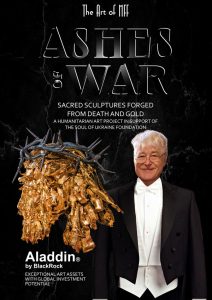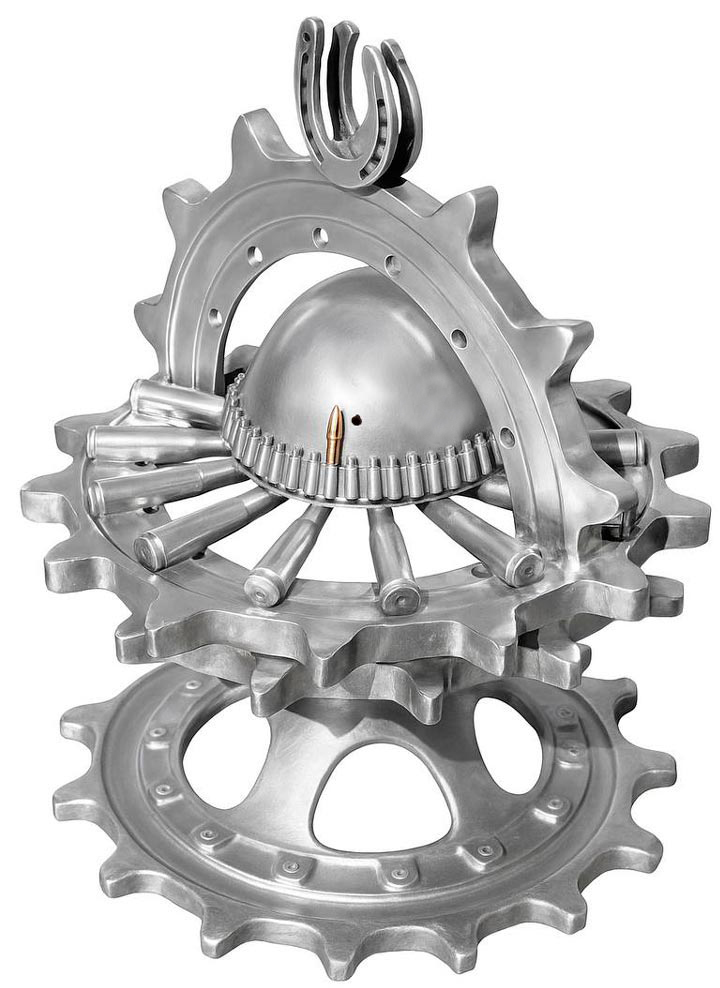
Details
THE FATE OF A SOLDIER
The installation is composed of authentic remnants from the battlefield: a bullet-pierced helmet once worn by a Russian soldier and recovered in the Kherson region, a machine gun belt with a single golden bullet, a gear wheel from an armored personnel carrier, and horseshoes — a bitterly ironic symbol of “luck” in war. This work of art serves as a stark reminder of the true cost of war.
Dimensions: 110 х 79 cm
Gross Weight: ~80 kg
Year of creation — 2023
Provenance
The Author: Sergey Melnikoff (MFF).
This work of art was created in Odesa, Ukraine, in 2023, during a critical phase of the Russian-Ukrainian war.
Owner: The installation The Fate of a Soldier was donated by the author to the State Border Service of Ukraine in 2025.
The Fate of a Soldier
Sergey Melnikoff, known in the art world as MFF, delivers a chilling and symbolic reflection on the human cost of war in his sculpture The Fate of a Soldier. This powerful installation is crafted entirely from authentic battlefield artifacts collected from combat zones during Russia’s full-scale invasion of Ukraine. It is not an abstract work—it is a physical embodiment of pain, sacrifice, and irony.
At its core lies a rusted, battle-worn soldier’s helmet, unmistakably real and unmistakably Russian. This is no replica or metaphor; it is a relic torn from the battlefield, pierced through by a bullet—a silent witness to the instant a life was ended. The helmet does not romanticize death. Instead, it presents it raw, intact, and unfiltered. The hollow within is the void left by war.
Encircling the helmet is a machine gun cartridge belt, wrapped like a brutal halo. Among dozens of dark, spent rounds, one glints gold—a single golden bullet. This solitary golden round stands apart, a stark emblem of fate, finality, or perhaps divine judgment. Does it represent the bullet that killed, or the one yet to find its mark? Is it valor, destiny, or sheer irony?
The entire composition rests upon a toothed drive wheel from an armored personnel carrier—a literal fragment of war’s machinery. Its jagged perimeter speaks of relentless motion, of metal grinding over terrain, over lives, over borders. The soldier, whose helmet sits above it, is both victim and gear in this merciless system.
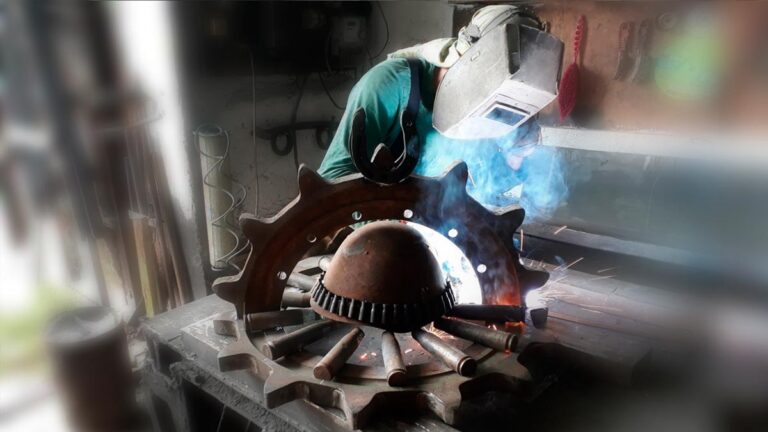
The Art of MFF | Electric welding in progress during the assembly of The Fate of a Soldier installation. Victor Bielchyk as a welder.
Photo by MFF
And crowning the piece: two horseshoes, mounted upright. Traditionally a symbol of luck, their inclusion here is layered with bitter contradiction. Are they meant to guard the fallen soul of the soldier? Or do they mock the myth of the “lucky one” in a war where luck is just the absence of death?
Melnikoff’s The Fate of a Soldier does not idealize or abstract. It confronts. Each element in the sculpture was once part of war’s reality—metal that killed, shielded, or moved through destruction. This sculpture forces the viewer to reconcile the cold brutality of military objects with the warm, irreplaceable humanity that vanishes beneath them.
In transforming these instruments of violence into a single sculptural testimony, Melnikoff performs an act of spiritual reclamation. He does not let these fragments rust into silence. Instead, he gives them voice—stern, accusatory, unforgettable.
This is not merely art. It is a battlefield frozen in time. A monument not to glory, but to consequence.
The Fate of a Soldier
A gift by the author to the State Border Service of Ukraine.
This powerful sculpture is composed of authentic battlefield relics from the war in Ukraine. At its center is a Russian soldier’s helmet, pierced by a fatal bullet and encircled by a machine gun cartridge belt with a single golden bullet—symbolizing the randomness of death in war. The base is formed from a drive wheel of an armored personnel carrier, and the top is crowned with two upright horseshoes, a traditional symbol of luck, turned ironic in the context of war.
The Fate of a Soldier is a stark reminder that behind every piece of military hardware lies a human life—lost, forgotten, or destroyed.
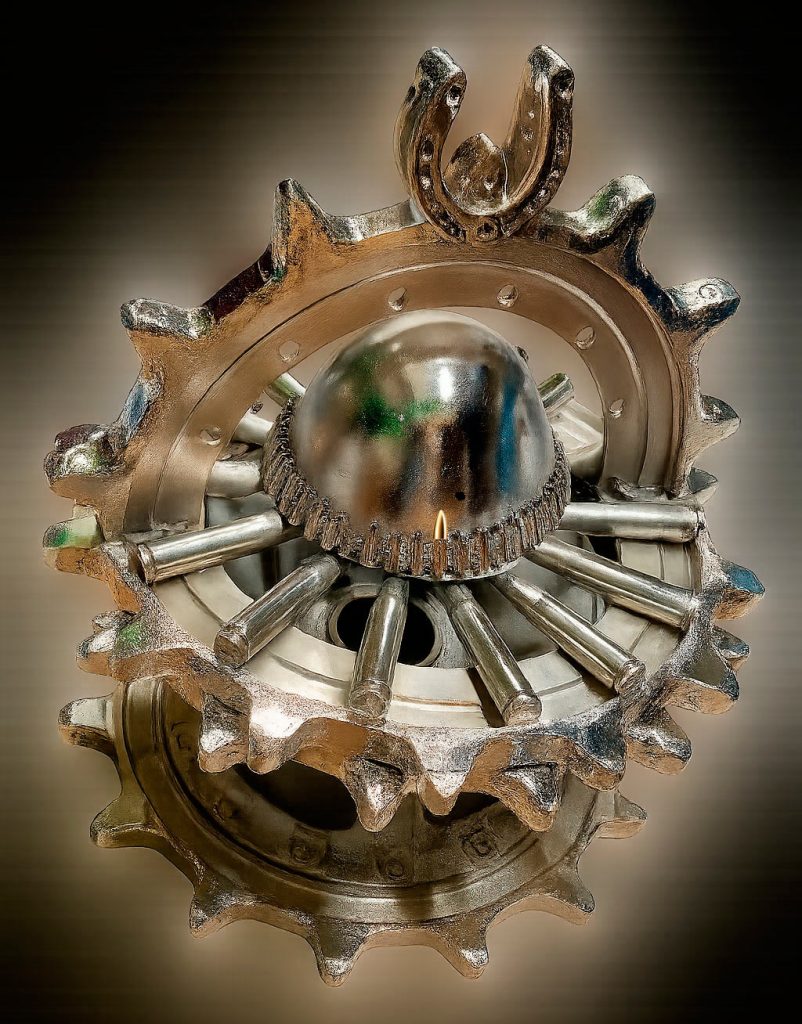
The Art of MFF | The central part of the installation “Fate of a Soldier”
The photos record the process of creating the installation “The Fate of a Soldier”: a stainless-steel pedestal with a trident assembled from fragments of mines and shells. The stand for the explanatory plaque is made from a 155 mm artillery shell. The details of the installation, cleaned with a sandblasting machine at the final stage before nickel plating and after the galvanic bath, resemble the wounds of war being healed before a new life. Metal once intended for destruction is transformed into a symbol of memory and strength.
Brought to you by
Related Promotional digital booklets
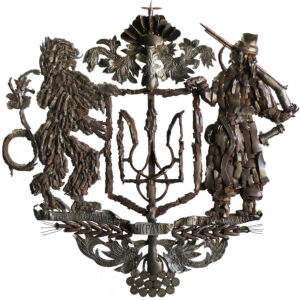
Ashes of War
Experts and ChatGPT currently value MFF’s sculptures, forged from the “ashes of war,” between $150,000 and $1,000,000.
Private collectors and investors can also commission works—from state emblems to corporate logos. Such pieces not only carry cultural weight but are seen as a safeguard against inflation.


